I'm having trouble getting my code to follow CLRS's example of a Minimum Spanning Tree (MST) in page 635. I'm also implementing CLRS's pseudo-code for MST-Prim quite literally, which is
In particular, I'm implementing the following graph using an adjacency list:
So I actually have two issues. The first is that after adding the node b to the MST, my code picks as next element in the PriorityQueue node h instead of node c. I'm not sure how Java's implementation picks elements in case of ties, so if there's something I can do about this please advise.
To temporarily circumvent this issue I modified the edge a-h to have a weight of 9.
Everything then runs fine until it picks node d instead of g after adding f to the MST, which I find really strange since the PriorityQueue clearly has g with key=6.
My implementation is below:
import java.util.LinkedList;
import java.util.PriorityQueue;
class Edge{
private Node source;
private Node destination;
private int weight;
public void setSource(Node source) {
this.source = source;
}
public void setDestination(Node destination) {
this.destination = destination;
}
public void setWeight(int weight) {
this.weight = weight;
}
public int getWeight() {
return this.weight;
}
public Node getSource() {
return this.source;
}
public Node getDestination() {
return this.destination;
}
}
class Node implements Comparable<Node>{
private String label;
private LinkedList<Edge> edges;
private int key;
private Node daddy;
Node() {
this.edges = new LinkedList();
}
public void setLabel(String label) {
this.label = label;
}
public void setKey(int key) {
this.key = key;
}
public void setDaddy(Node daddy) {
this.daddy = daddy;
}
public String getLabel() {
return this.label;
}
public int getKey() { return this.key; }
public LinkedList getEdges() {
return this.edges;
}
@Override
public int compareTo(Node o) {
if (this.getKey() > o.getKey()) {
return 1;
}
else if (this.getKey() < o.getKey()) {
return -1;
}
else {
return 0;
}
}
}
public class Graph {
private int numberOfNodes;
private Node[] weightedGraph;
public Graph(int graphV) {
this.numberOfNodes = graphV;
this.weightedGraph = new Node[this.numberOfNodes];
for (int i = 0; i < this.numberOfNodes; i++) {
this.weightedGraph[i] = new Node();
}
}
public void addEdge(String sourceLabel, String destinationLabel, int weight) {
Node sourceNode = null;
Node destinationNode = null;
for (Node node: this.weightedGraph) {
if (node.getLabel().contains(sourceLabel)) {
sourceNode = node;
}
if (node.getLabel().contains(destinationLabel)) {
destinationNode = node;
}
}
Edge e = new Edge();
e.setWeight(weight);
e.setSource(sourceNode);
e.setDestination(destinationNode);
sourceNode.getEdges().add(e);
}
public void minimumSpanningTree(String root) {
Node rootNode = null;
for (Node vertex: this.weightedGraph) {
vertex.setKey(Integer.MAX_VALUE);
vertex.setDaddy(null);
if (vertex.getLabel().contains(root)) {
rootNode = vertex;
}
}
rootNode.setKey(0);
PriorityQueue<Node> nodePriorityQueue = new PriorityQueue<>();
for (Node vertex: this.weightedGraph) {
nodePriorityQueue.add(vertex);
}
int min = 0;
while (!nodePriorityQueue.isEmpty()) {
Node u = nodePriorityQueue.peek();
LinkedList<Edge> uEdges= u.getEdges();
for (Edge e: uEdges) {
Node v = e.getDestination();
int u_vWeight = e.getWeight();
if (nodePriorityQueue.contains(e.getDestination()) && u_vWeight < v.getKey()) {
v.setDaddy(u);
v.setKey(u_vWeight);
}
}
nodePriorityQueue.remove(u);
min += u.getKey();
}
}
public static void main(String[] args) {
Graph graph = new Graph(9);
String[] nodes = new String[9];
nodes[0] = "a";
nodes[1] = "b";
nodes[2] = "c";
nodes[3] = "d";
nodes[4] = "e";
nodes[5] = "f";
nodes[6] = "g";
nodes[7] = "h";
nodes[8] = "i";
int pos = 0;
for (String s: nodes) {
graph.weightedGraph[pos].setLabel(s);
pos += 1;
}
graph.addEdge("a", "b", 4);
graph.addEdge("a", "h", 9);
graph.addEdge("b", "h", 11);
graph.addEdge("b", "c", 8);
graph.addEdge("h", "i", 7);
graph.addEdge("i", "g", 6);
graph.addEdge("c", "f", 4);
graph.addEdge("c", "d", 7);
graph.addEdge("d", "e", 9);
graph.addEdge("d", "f", 14);
graph.addEdge("e", "f", 10);
graph.addEdge("h", "g", 1);
graph.addEdge("c", "i", 2);
graph.addEdge("g", "f", 2);
graph.minimumSpanningTree("a");
}
}
Essentially I have three classes, Node, Edge and Graph. I included a Comparator in Node to allow the PriorityQueue to reorder elements as needed.
I build the graph, call minimumSpanningTree, which prints the following MST:
a
b
c
i
f
d
e
h
g
Instead of doing a-b-c-i-f-g as in CLRS's example which I show below:

I don't really understand why it's picking node d instead of g when g clearly has the lowest key, which inspecting by debugging the priorityQueue corroborates.
Help is greatly appreciated.
